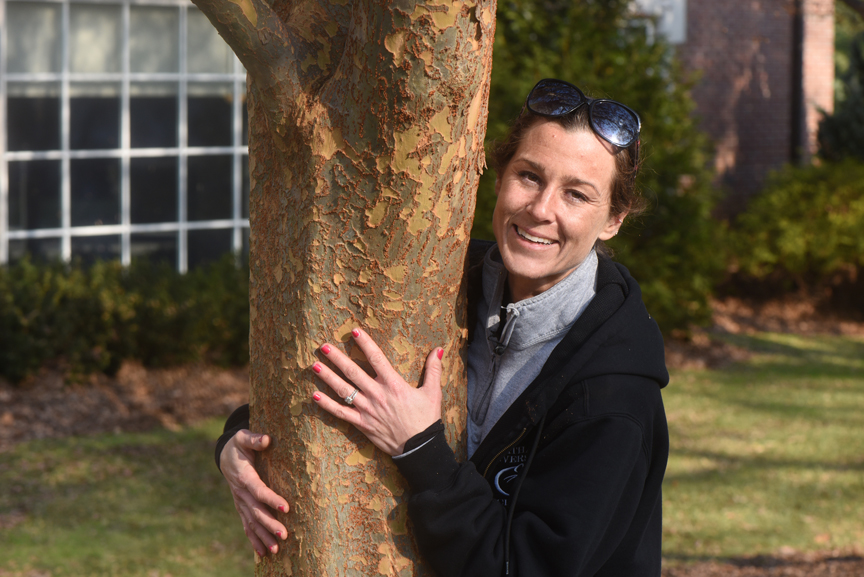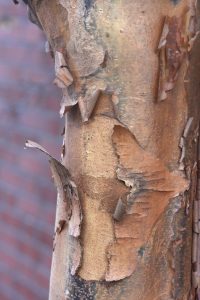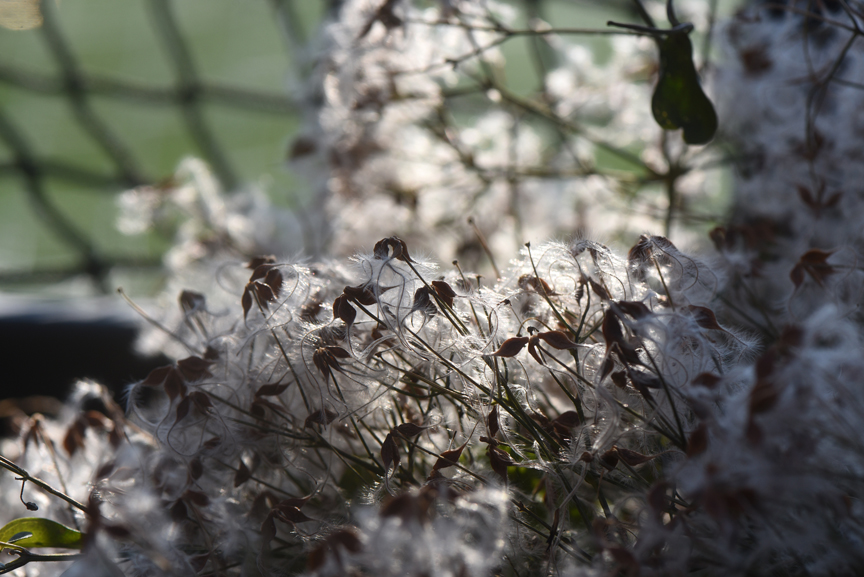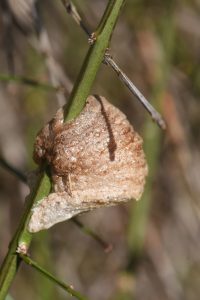Plants with winter interest showcased at Chatham University arboretum
Posted on: December 26, 2018 | Written By: Doug Oster |
Huge sycamore trees along Woodland Road and throughout the campus of Chatham University tower over Kristen Spirl as she remarks on their seasonal beauty after it snows.
“It’s really a beautiful sight. Right after the sun opens up, we have these sycamore trees, and the light hits their white bark,” she said with a smile. “It really makes beautiful winter interest.”
Spirl is grounds department manager and arboretum coordinator here. Many people don’t know that Chatham is an official American Public Gardens Association arboretum filled with historic and interesting plantings, some dating to the 19th century.

Kristen Spirl is grounds department manager and arboretum coordinator at Chatham University. The confessed “tree hugger” shows off some of the plants with winter interest on campus including this Chinese lacebark elm.

Paperbark maples are one of the plants that stands out in the winter on Chatham University’s campus which is also an arboretum.
They are labeled for easy identification, and it’s free to see these significant horticultural specimens.
The campus and arboretum comprise land that once was estates of the Laughlin family, Andrew Mellon and others.
As Spirl continues her walk through the campus, old-fashioned, deep-red roses hold on to their last blooms. She points out pretty vining plants filled with fluffy white growth often called Traveling Beard, as they resemble an old man’s beard.
“Sweet autumn clematis seed head stay around for winter before it gets dispersed,” she said. “It’s really beautiful and delicate looking, especially when it’s covered in snow.”
The landscape can be interesting year round Spirl said. She also has worked to plant other things that are garden stars even this time of the year.
“Winter is dreary, and having areas where you can have the pop of color is really nice and gets everybody’s spirits up,” Spirl said.
This is also a good time to discover plants with winter interest that can be added to the home garden.
With her team, she has added nearly 50 witch hazel plants around campus, as they put on a show when most plants sleep.
“The magic of witch hazel is that it blooms in the winter, and it blooms in a lot of different colors,” she said. “There’s also a variety that blooms in the fall. They also look like little pieces of hair off of the branch.”

Sweet autumn clematis is one of the plants that stands out in the winter on Chatham University’s campus which is also an arboretum.

Kristen Spirl saw this praying mantis egg casing in a winter blooming jasmine plant.
Dark purple ajuga hugs the ground between the lawn and a brick wall as red twig dogwoods and oak leaf hydrangeas stand over the planting. The hydrangea has many seasons of interest and is a reliable bloomer. White conical flowers fade to dark pink. The huge leaves turn deep red in the fall and when gone reveal a bronze exfoliating bark.
Another unique tree is a Chinese lacebark elm. It’s a fast growing tree with multi-colored bark and good resistance to Dutch elm disease.
In a small courtyard, an unusual winter bloomer is just putting buds on, and Spirl spots a praying mantis egg casing at the bottom of the plant.
“Winter blooming jasmine has a beautiful yellow flower, she said. “When that thing explodes, it is beautiful. It looks like it’s forsythia. It’s graceful with tiny little five-leaf flowers that stand out against the winter snow.”
The bark of smooth magnolias and silver and sugar maples are showy. The peeling cinnamon-colored bark of paperbark maple is magnificent.
“The beech trees have that beautiful elephant-looking dark gray shiny bark which really looks beautiful with snow around it,” Spirl said.
She’s busy year round but always takes time to enjoy and record the beauty of the winter landscape.
“Everybody on campus knows that I’m the crazy person that stops and takes pictures of everything and lays down in the middle of the road if the picture looks good,” she said, laughing.
She also enjoys looking at the bones of the landscape. She’s particularly fond of oaks.
“The architecture of all the trees, this is my favorite time to look at them. Their branching structure is fantastic,” she said of oak trees. “It starts very upright, and it unfolds to the lateral.”
Dawn redwoods are also a good example, as they can reach 100 feet tall and are deciduous conifers with interesting bark and branching pattern.
The bark of dogwoods in the arboretum can have interesting color, as well.
“I think dogwood seed heads are really pretty, too,” said Spirl. The fronds of grasses dance in the breeze when left up for the winter.
“My favorite ornamental grass is a small one,” she said. That would be ‘Praire Dropseed.’
Beautyberry shrub is covered in deep purple, edible berries, which is the perfect color for the university. “Chatham purple,” Spirl said, proudly. “We try to put it all around campus.”

Beautyberry is a plant with great winter interest.
As any gardener knows, plants die, that’s part of gardening. But when they are part of an important landscape like this one, it can be particularly devastating.
“Everything has a life span,” she said, “and everything can get affected by weather, bugs, people. It’s very hard, because I’ve spent a lot of time with these trees. If it’s a beautiful tree that has a really special place in our Chatham heritage, we try and preserve it and reuse it on campus.”
Branches from an ancient Japanese maple that died have been turned into holiday decorations, and other plants have become artwork on the campus.
“The joy of seeing the winter garden, you can see all of the squirrels up in trees, you can see all of the fruit, the leaves remaining,” Spirl said. “It’s like discovering little flowers that you didn’t know existed. Nature makes all these beautiful things, you just need to look at them.”
Doug Oster is editor of Everybody Gardens, a website operated by 535Media, LLC. Reach him at 412-965-3278 or doster@535mediallc.com. See other stories, videos, blogs, tips and more at everybodygardens.com.
Details – For information on how to see the arboretum at Chatham University and about parking go to chatham.edu.
More from Everybody Gardens
A Christmas cactus passed down for generations.